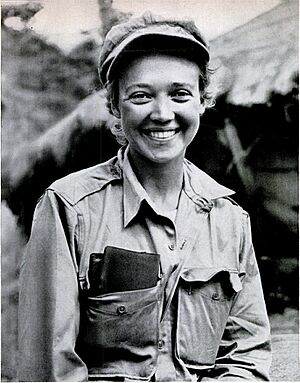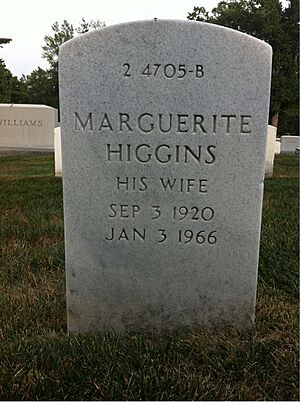Marguerite Higgins facts for kids
Quick facts for kids
Marguerite Higgins
|
|
|---|---|

Photo from October 1951 Life magazine article by Carl Mydans
|
|
| Born | September 3, 1920 |
| Died | January 3, 1966 (aged 45) Washington, D.C., US
|
| Burial place | Arlington National Cemetery |
| Occupation | reporter and war correspondent |
| Known for |
|
Marguerite Higgins Hall (September 3, 1920 – January 3, 1966) was an American reporter and war correspondent. She reported on major conflicts like World War II, the Korean War, and the Vietnam War.
Marguerite Higgins helped open doors for other female war correspondents. She worked for the New York Herald Tribune for many years. Later, she became a syndicated columnist for Newsday. In 1951, she became the first woman to win a Pulitzer Prize for Foreign Correspondence. This award was for her brave reporting during the Korean War.
Contents
Early Life and School
Marguerite Higgins was born in Hong Kong on September 3, 1920. Her father worked for a shipping company there. Her parents met in Paris during World War I. Three years later, her family moved to Oakland, United States.
When she was eight, her father lost his job during the 1929 stock market crash. This made her worry about how she would earn a living. She wrote in her book that this was the "worst day" of her childhood. It made her determined to find a good job when she grew up.
Her family managed to get by. Her father found a new job at a bank. Her mother helped Marguerite get a scholarship to the Anna Head School in Berkeley.
College Days at Berkeley and Columbia
In 1937, Higgins started college at the University of California, Berkeley. She joined a sorority and wrote for the student newspaper, The Daily Californian. She even became an editor there in 1940.
After graduating from Berkeley in 1941, she moved to New York City. She wanted to become a newspaper reporter. She decided to give herself one year to find a job. If not, she would go back to California and teach French. She also applied to the Columbia University School of Journalism.
Getting into Columbia was tough because most spots for women were full. But Marguerite was very determined. She gathered all her transcripts and recommendation letters quickly. A spot opened up just before classes started, and she got in.
One of her professors, John Tebbel, said she was very smart and ambitious. He noted that women had to be extra tough to succeed in journalism back then. In 1942, she became the campus reporter for the New York Herald Tribune. This led to her full-time job as a reporter.
Reporting from Around the World
Marguerite Higgins was eager to become a war correspondent. In 1944, after two years at the New York Herald Tribune, she convinced them to send her to Europe.
World War II in Europe
She was first stationed in London and Paris. In March 1945, she moved to Germany. She witnessed the liberation of the Dachau concentration camp in April 1945. She even helped during the surrender of the S.S. guards there. For this, she received a U.S. Army campaign ribbon.
After the war, she covered the Nuremberg Trials, where Nazi war criminals were judged. She also reported on the Soviet Union's blockade of Berlin. In 1947, she became the chief of the Tribune's office in Berlin.
Reporting on the Korean War
In 1950, Higgins became the chief of the Tribune's office in Tokyo, Japan. Soon after she arrived, the Korean War broke out. She was one of the first reporters to arrive in Korea.
On June 28, she and three other reporters were trapped when the Hangang Bridge bombing happened. They had to cross the Han River by raft. The next day, General Walton Walker ordered her to leave Korea. He said women did not belong at the front lines.
Higgins did not give up. She appealed directly to General Douglas MacArthur, a very powerful military leader. General MacArthur sent a telegram saying that the ban on women reporters was lifted. He also said Marguerite Higgins was highly respected. This was a huge step forward for all female war correspondents. Her fight to stay in Korea made headlines and made her famous.
While in Korea, another reporter, Homer Bigart, was sent by the Tribune. He told Higgins to go back to Tokyo, but she refused. The Tribune let her stay. This led to a friendly competition between them. Both Higgins and Bigart, along with four other male reporters, won the 1951 Pulitzer Prize for International Reporting for their coverage of the Korean War.
Covering Global Events
Because of her excellent reporting from Korea, Higgins received the George Polk Memorial Award in 1950. She continued to cover foreign affairs for the rest of her life. She interviewed important world leaders like Nikita Khrushchev from the Soviet Union.
In 1955, she became the chief of the Tribune's office in Moscow. She was the first American reporter allowed back into the Soviet Union after Stalin's death.
Reporting from Vietnam
In 1963, she joined Newsday and was sent to cover South Vietnam. She visited many villages and interviewed key figures. She wrote a book about her experiences called Our Vietnam Nightmare.
In Vietnam, she had disagreements with another reporter, David Halberstam. Higgins had strong anti-Communist views. She believed that some protests against the South Vietnamese government were started by communists. Halberstam and other younger reporters disagreed. They felt Higgins's views were too strong. Higgins believed they didn't understand the war fully. She felt they stayed mostly in the city and didn't see what was happening in the countryside.
Personal Life
While at Berkeley, Marguerite met Stanley Moore, a philosophy teaching assistant. They later married in 1942. However, their marriage ended in divorce in 1947 after he was drafted into World War II.
In 1952, she married William Evens Hall, a U.S. Air Force major general. They settled in Marin County. Their first daughter was born prematurely in 1953 and sadly died five days later. In 1958, she had a son named Lawrence. In 1959, she had a daughter named Linda.
Death and Legacy
When Marguerite Higgins was six months old, she got malaria. Doctors sent her to a mountain resort in what is now Vietnam to recover. Decades later, in November 1965, Higgins returned from her assignment in South Vietnam. She had contracted leishmaniasis, a serious disease. She died on January 3, 1966, at the age of 45, in Washington, D.C. She is buried at Arlington National Cemetery with her husband.
Marguerite Higgins was honored for her work. In 1946, Secretary of War Robert P. Patterson recognized her and other war correspondents. In 2010, South Korea gave her one of its highest honors, the Order of Diplomatic Service Merit Heungin Medal. This award recognized her bravery in telling the world about South Korea's fight for survival in the 1950s. In 2016, South Korea's Ministry of Patriots and Veterans Affairs named her a Korean War Heroine of May.
See also
 In Spanish: Marguerite Higgins para niños
In Spanish: Marguerite Higgins para niños


